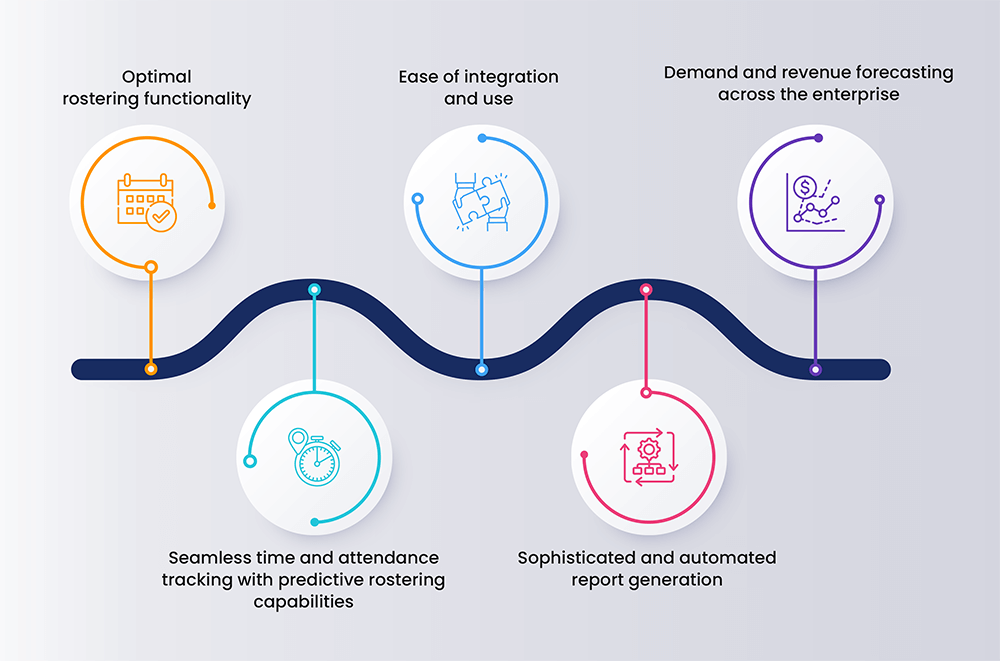No matter the size of an organization, it is crucial to schedule employee work times with laser-sharp precision, especially when they are required to work in shifts to meet output demands. In addition, efficient and digital employee rostering improves overall productivity and smooth organizational functioning. An effective employee roster app can do this and much more.
HR professionals and shift managers often struggle with manual shift scheduling, conflicts, and over or underpayments, especially in industries with geographically diverse, shift-based employees or gig workers, such as CPG, manufacturing, energy & utilities. With relevant information on employees, like their location, work timings, and job responsibilities, available at the click of a button on an employee roster app, managers can have one eye on the shop floor or mine’s frontline workers at all times to ensure productivity and pre-empt issues emerging from over or understaffing.
Move your employee roster app out of the 70s with digitization and automation
Traditional employee rostering was a paper-based list of employees, where signing in and out determined their hours at work. This employee rostering process was inaccurate and prone to errors, even a lack of integrity in some cases. Not to mention, it really killed employee experience at all levels. In manufacturing or other industrial shop floors, employee roster app records help relevant leaders and managers understand expected output and staffing needs at each location. Manual rostering’s inaccuracies beat the very purpose of stringent record-keeping. Manual rostering can also cause schedule conflicts and makes staffing predictions impossible or highly tedious, given that staffing data needs to be fed into HR Management Systems for any analytics-based decisioning.
Whether punching time cards or signing into a register, it is time for organizations to move away from archaic techniques and adopt an effective employee roster app. It is possible to digitize the employee rostering process, creating real-time visibility for supervisors, digital data collection, and correlation for analytics, making shift management hyper-efficient and cost-optimized while improving employee experience. When you miss out on these benefits of digital employee rostering, minor issues could eventually snowball into production shortfall, impact customer and frontline workers’ employee experience, and influence your company’s reputation.
What goes into the making of an effective employee roster app: 5 critical capabilities
Given the diverse workforce distribution in industrial sectors like manufacturing, energy & utilities, and CPG, managing employee rostering to ensure high productivity and cost-efficiency is vital. An entire gamut of operations and HR team interrelated functions stems from efficient employee rostering. This makes data accuracy, real-time reporting, and automated report generation essential for an employee roster app.
If you are reading this, you’ve probably felt the need to change how you manage your employee rostering. It’s time for employee rostering processes to go beyond being a simple record-keeping task.
An effective employee roster app should not only track the hours your employees and gig workers are at work and manage shift rotations across multiple locations but also assign specific tasks and projects and generate reports for adequate staffing and accurate payment decisions. Ultimately, your employee roster app should work towards reducing absenteeism and tardiness, saving operational costs, and enhancing production efficiency.
Given the specific and high-stakes goals of an effective employee roster app, here are the top capabilities you need to look out for.

1. Optimal rostering functionality
The employee roster app should enable efficient shift and job scheduling and employee rostering across multiple locations or time zones. In industries such as CPG manufacturing, the effectiveness of this employee rostering will be determined by the expected output based on existing contracts or expected outcomes. In other industrial sectors like oil, energy, or utilities, the shifts’ productivity would determine the grid supply expectations and needs.
An effective employee roster app must align employee skill sets and availability with ease and without friction. The employee rostering efficacy would be determined by its agility in building and replicating employee rosters with ease, easy-to-manage shift-swapping, easy clock-in and clock-out, and digital attendance records.
2. Ease of integration and use
The ease and seamlessness of employee management and resourcing functions often depend on data access and connectivity. Employee rostering is no different. Therefore, the employee roster app you choose easily must integrate with the other existing HR systems within your organization, like payroll and LOB, without disrupting any operational functions and processes.
Employee time records should be directly linked to payroll, benefits & compensation, and people analytics tools to enable a birds’ eye view of productivity, performance, and costs. Easy setup and ease of use are also crucial factors to ensure usage and engagement on the employee roster app among your business users with varying levels of comfort with technology.
3. Seamless time and attendance tracking with predictive rostering capabilities
Employee attendance and time records across all manufacturing and other industrial sectors form the data foundation to govern output and efficiency. Across multiple locations, the amount of time your workforce takes to complete scheduled tasks determines not only productivity but also the impact it could have on other collaborators along the assembly line and the overall operational efficiency.
Attendance recording is also critical in an employee roster app to ensure adequate staffing throughout the year. These records highlight issues on the shop floor and possible effects on the bottom line.
Based on the accessible digitized data, the human resources team can control resourcing, predict over or understaffing issues and take timely action. This ensures that your production and operational needs are met without disruption or delays. Predictive rostering is a key capability to look out for in your chosen employee roster app.
4. Sophisticated and automated report generation
For data-driven decisions across the enterprise, contemporary organizations can no longer do without need-based, birds’ eye view or granular drilled-down reports. For this to happen, production data must be correlated with employee roster app data for precise analytics and insights.
These capabilities in an employee roster app are essential to understand production numbers and efficiency and allow for an overview of the expected bottom line. Your employee rostering should generate fundamental and actionable insights through holistic, real-time reports on workforce planning, talent management, wage cost management, and company-wide profitability.
5. Demand and revenue forecasting across the enterprise
If you are wondering what an employee roster app has to do with demand and revenue predictions, it is all in the numbers and the workforce. Employee roster app has hidden insights that you didn’t know you had. Your historical efficiency, productivity, and cost data culled from employee rosters can be analyzed to predict revenue vs. costs and peak demand periods through the hidden insights in employee rostering. In addition, it helps leadership teams determine the process changes that can aid in increasing productivity and cost-efficiency during future peak or low-demand periods.
The overview that the top management and managers gain from employee roster app reports allows timely interventions. Therefore, efficient employee rostering directly impacts multiple related operational processes and an organization’s ability to meet customer needs.
Though an employee roster app can be built in-house with an expert technical team, it is cost-intensive and time-consuming. This is especially true for organizations that want employee rostering to move beyond attendance record-keeping and use this crucial data source for effective decisions and improve employee experience.
Acuvate's Employee Roster App: Combining off-the-shelf convenience with data engineering excellence
Acuvate’s engineers recently built a low code/ no code Employee Roster App to achieve the potential of employee rostering in enterprise-wide profitability. Our employee roster app comes embedded in Microsoft Teams, which many organizations already use for workforce collaboration and enterprise communication. This ensures high familiarity and engagement among all business users.
The easy-to-install and use employee roster does not require additional resources from the organization to be up and running. In addition, Acuvate’s employee roster app is easily integrate-able with existing payroll and LOB systems for holistic reporting and insights.
For managers assigning roles and adding or swapping shifts, Acuvate’s employee roster app provides one-click access to shift calendars and single-touch roster sharing with relevant managers, thus addressing shift conflicts and duplications. Workers, too, can request shift swaps and leaves with ease on this new-age employee roster app.
For those at supervisory levels, the employee roster app enables easy access to the roster with drilled-down granular details of workers on each shift, assigned, and expected output numbers on a daily, weekly and monthly basis. Insights into employee availability become a matter of seconds through effective employee rostering, unlike when this information is collated using paper-based shift and leave records.
Acuvate, with its almost two decades of seasoned data and analytics expertise using the Microsoft stack, has built a deceivingly simple employee roster app with some significant reporting capabilities. Available at the click of a button, the employee roster app’s reporting reveals metrics that matter, such as labor costs, shift fulfillment, and financial summaries against each worker based on hours worked. These insights collectively empower individuals, managers, and leaders to improve productivity, profitability, and employee experience.
Acuvate’s employee roster app combines the superpowers of Microsoft’s Power Platform (Power Apps and Power Automate) to automate tedious functions like shift scheduling and swapping and deliver a powerful and easy-to-navigate UI for managers and employees. In addition, the employee roster app combines Dataverse and Power BI for analytics and reporting to transform your employee rostering process into a robust decision-support system. The Microsoft Power Platform allows the employee roster app to be a no code low solution for building custom apps, workflow automation and generating insights.
Do more with employee rostering with Acuvate's Roster App
270 million employees around the world use Microsoft Teams every day for enterprise collaboration and communication. Integrating an easy-to-use and navigate employee roster app on Teams translates to improved engagement and usage. This creates a significant source of actionable data to improve profitability and efficiency, not just for every shift but for your overall organization.
Request a demo and take your employee rostering out of the 1970s!





